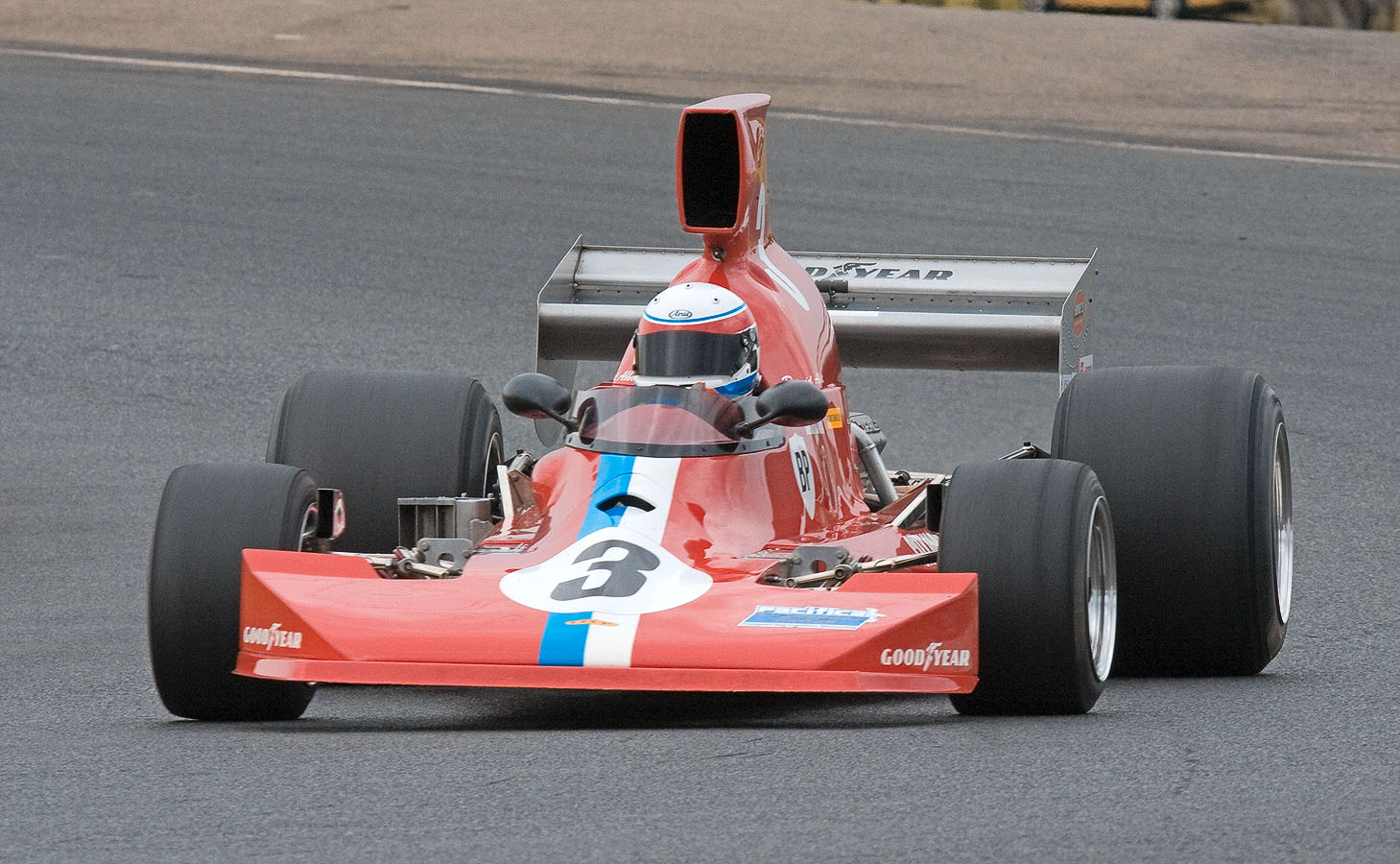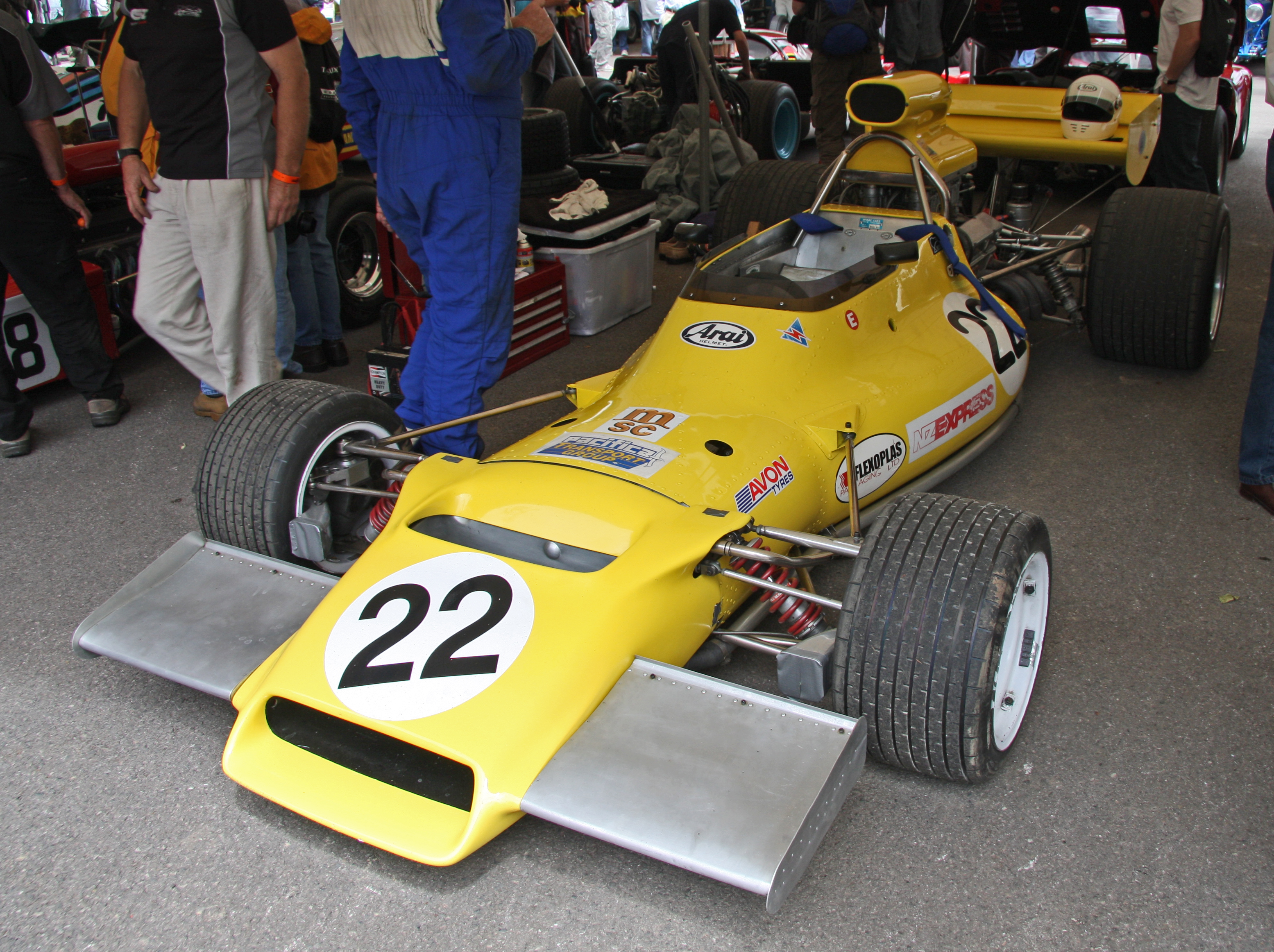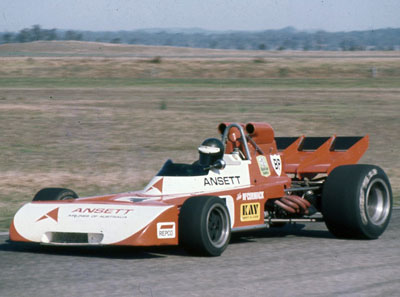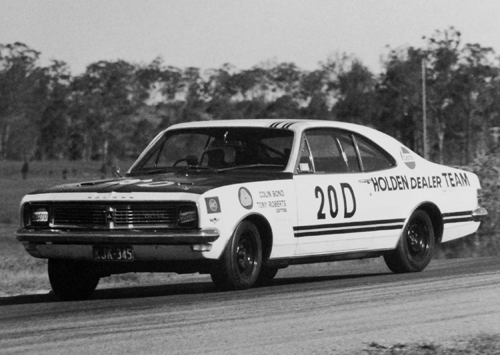|
1979 Rothmans International Series
The 1979 Rothmans International Series was an Australian motor racing series open to Australian Formula 5000, World Formula 1 and Australian Formula Pacific cars.Programme, Oran Park International, 25 February 1979 It was the fourth and final Rothmans International Series.The Macquarie Dictionary of Motoring, 1986, page 414 The series was won by Larry Perkins driving an Elfin MR8 Chevrolet. Calendar The series was contested over four rounds with one race per round.''Rothmans International Series'', Australian Motor Racing Yearbook 1979/80, pages 178 to 189 Points system Points were awarded on a 10-9-8-7-6-5-4-3-2-1 basis for the first ten places at each of the first three rounds.Wolfgang Klopfer, Formula 5000 in New Zealand & Australia: Race by Race, pages 204 to 208 Points were awarded on a 15-14-13-12-11-10-9-8-7-6-5-4-3-2-1 basis for the first fifteen places at the fourth round. Series results {, class="wikitable" generated with :de:Wikipedia:Helferlein/VBA-Macro fo ... [...More Info...] [...Related Items...] OR: [Wikipedia] [Google] [Baidu] |
Rothmans International Series
The Rothmans International Series was an Australian motor racing series which was staged annually from 1976 to 1979. Initially open to Australian Formula 1 cars (commonly referred to as Formula 5000s), for the final year it was for ‘’Australian Formula 5000’’, ‘’World Formula 1’’ and ‘’Australian Formula Pacific’’ cars.Programme, Oran Park International, 25 February 1979, page 17 History When the joint Australian-New Zealand open-wheeler series, the Tasman Series was discontinued after the 1975 series, the four Australian former Tasman races became the Rothmans International Series. The series was run during February of each year from 1976 to 1979, with races at Sandown, Adelaide International Raceway, Oran Park and Surfers Paradise International Raceway. Future (1983) 24 Hours of Le Mans winner Vern Schuppan, driving for Theodore Racing, won the 1976 Rothmans International Series in a Lola T332- Chevrolet with the final round at Surfers Paradise being ... [...More Info...] [...Related Items...] OR: [Wikipedia] [Google] [Baidu] |
Warwick Brown
Warwick Brown (born 24 December 1949 in Sydney) is a former racing driver from Australia. Racing career Brown participated in a single Formula One Grand Prix, on 10 October 1976. He drove a Wolf–Williams Racing car at the 1976 United States Grand Prix and finished 14th, five laps behind the winner James Hunt. Brown suffered the loss of third and fifth gears during the race, as well as rear brake problems.Young, Eoin, "James Hunt: Against All Odds", Hamlyn, 1977, p. 132. Brown was more successful in the Tasman Series, which he won in 1975, driving a Lola T332 Chevrolet. He also won the Rothmans International Series in Australia twice, in 1977 driving a Lola T430 Chevrolet and in 1978 driving a Lola T332 Chevrolet, both for the VDS Team. In the course of winning these series Brown also won the 1975 New Zealand Grand Prix and the 1977 Australian Grand Prix. After competing in the SCCA/USAC Formula 5000 Championship in North America from 1974 to 1976, Brown contested the Can-A ... [...More Info...] [...Related Items...] OR: [Wikipedia] [Google] [Baidu] |
Geoff Lees (racing Driver)
Geoffrey Lees (born 1 May 1951) is a former racing driver from England. He participated in 12 Formula One World Championship Grands Prix, making his first appearance on 16 July 1978. He scored no championship points. Career Lees was born near Kingsbury, Warwickshire. His first Grand Prix chance came with a non-works Ensign ran by Mario Deliotti, the owner of an Alfa Romeo dealership in Birmingham, at his home race in 1978. Lees failed to qualify. The following year he had a one-off drive for Tyrrell, before a more regular ride with the struggling Shadow team in 1980. Later that year he also drove for the works Ensign team, and failed to qualify a RAM-entered Williams in the US. He participated in the Formula One non-championship race held on 7 February 1981 at Kyalami for Theodore where he went into the crash barriers on lap 11 due to a broken front suspension. In the hope of taking one step backward and then two steps forward, he joined Ralt-Honda for the European Formula ... [...More Info...] [...Related Items...] OR: [Wikipedia] [Google] [Baidu] |
McRae GM3
Graham McRae (5 March 1940 – 4 August 2021) was a racing driver from New Zealand. He achieved considerable success in Formula 5000 racing, winning the Tasman Series each year from 1971 to 1973, and also the 1972 L&M Continental 5000 Championship in the United States. McRae's single outing in the Formula One World Championship was at the 1973 British Grand Prix on 14 July 1973, where he retired in the first lap. McRae also competed in the 1973 Indianapolis 500, finishing in 16th position and earning Rookie of the Year. Racing career McRae was born in Wellington, New Zealand. A qualified engineer, McRae competed in local sports car racing and hillclimbs in the early 1960s, notably at Levin and began to compete seriously in the 1.5 twin cam formula, which used old F3 chassis. After running a dated Brabham chassis, McRae built a slim, McRae, National Formula car which dominated the 1968–69 series, beating talented opponents in David Oxton, Ken Smith and Bert Hawthorne. He al ... [...More Info...] [...Related Items...] OR: [Wikipedia] [Google] [Baidu] |
Leyland P76
The Leyland P76 is a large car that was produced by Leyland Australia, the Australian subsidiary of British Leyland. Featuring what was described at the time as the "standard Australian wheelbase of 111 inches", it was intended to provide the company with a genuine rival to large local models like the Ford Falcon, the Holden Kingswood, and the Chrysler Valiant. But, due to the first real fuel crisis and demand far exceeding the supply, Leyland rushed the assembly process with the first of the P76s to come off the assembly line, resulting in poor build quality and some reliability problems. The combination of the rushed assembly, fuel crisis and strikes at the component manufacturers' factories, resulted in the Leyland P76 being labelled a lemon, despite receiving the Wheels magazine Car of the Year in 1973. By 1974, sales of the P76 had slumped and BMC decided to end the production of the P76. Although the P76 has been labelled a lemon in Australian motoring history, it is viewe ... [...More Info...] [...Related Items...] OR: [Wikipedia] [Google] [Baidu] |
McLaren M23
The McLaren M23 was a Formula One racing car designed by Gordon Coppuck, with input from John Barnard, and built by the McLaren team. It was a development of the McLaren M16 Indianapolis 500 car. A Ford Cosworth DFV engine was used, which was prepared by specialist tuning company Nicholson-McLaren Engines. This helped push the DFV's horsepower output to around 490 bhp. A total of 13 chassis were built, with serial numbers 1 to 12 and 14. No number 13 chassis was built, as it was deemed to be unlucky. History 1973 The M19 had reached the end of its development life and a new design was needed to keep pace with the latest generation of Formula One cars and regulations regarding deformable crash protection structures. Taking inspiration from the M16 Indycar and utilising the M19's rear suspension design, the new M23 was introduced for the 1973 Formula One season, 1973 season, and scored pole position with Denny Hulme on its very first outing. Hulme and Peter Revson took three ... [...More Info...] [...Related Items...] OR: [Wikipedia] [Google] [Baidu] |
John McCormack (racing Driver)
John McCormack is a former Australian racing driver. Originally from Tasmania, McCormack became one of the leading Formula 5000 racers in Australia during the 1970s. McCormack won the Australian Drivers' Championship three times, driving an Elfin MR5 Repco Holden in 1973, an Elfin MR6 Repco Holden in 1975 and a McLaren M23- Leyland in 1977. He also won consecutive New Zealand Grand Prix in 1973 and 1974. McCormack was competitive in the Tasman Series and Australian Grand Prix his best results being second in both events. Most of McCormack's major wins were under the banner of the Ansett Team Elfin. As well as open-wheelers McCormack drove sports sedans, winning the 1974 Toby Lee Sports Sedan Series driving his highly modified Chrysler Valiant Charger-Repco Holden V8 which underneath the Charger shell had specifications virtually identical to those of his Formula 5000 car. In 1979 McCormack was one of the first drivers to race a Chevrolet Camaro The Chevrolet Camaro is ... [...More Info...] [...Related Items...] OR: [Wikipedia] [Google] [Baidu] |
Vern Schuppan
Vernon John Schuppan (born 19 March 1943) is a retired Australian motor racing driver. Schuppan drove in various categories, participating in Formula One, the Indianapolis 500 and most successfully in sports car racing. Although he considers himself to be a single-seater driver, Schuppan's biggest career victory was with the factory-backed Rothmans Porsche team when he partnered Americans Hurley Haywood and Al Holbert to win the 1983 24 Hours of Le Mans driving the Porsche 956. In 1984 he was made a Member of the Order of Australia for "service to the sport of motor racing". Early career and Formula One After a successful karting career in which he won numerous Australian state and national titles, Schuppan made the decision to pursue a career in motor racing. He and his wife Jennifer ventured to Great Britain (with a self-imposed 2-year limit of making it big) to allow him to participate in the British Formula Atlantic Championship, which he won, leading to a test w ... [...More Info...] [...Related Items...] OR: [Wikipedia] [Google] [Baidu] |
Brabham BT43
The Brabham BT43 was the only Formula 5000 racing car built by Motor Racing Developments (MRD). Initiated by Ron Tauranac, designed by Geoff Ferris, and built by a team including Nick Goozee (monocoque) and Bob Paton (construction), it was one of the last cars produced by MRD before MRD was closed by the then new Brabham owner Bernie Ecclestone. Based on the Formula Two Brabham BT40 (which was also designed by Geoff Ferris) the BT43 featured a modified monocoque that incorporated the triangular cross section pioneered by the Brabham BT42 Formula One car which was designed by Gordon Murray. This distinctive pyramid shape not only kept the aerodynamic "stagnation point" low but also neatly allowed the incorporation of a "crushable structure" as required by the 1973 regulations which specified that all fuel tanks were to be protected by deformable structures. Engine and gearbox were the then de facto F5000 standard combination of a Chevrolet 302 cubic inch engine in an unstressed mou ... [...More Info...] [...Related Items...] OR: [Wikipedia] [Google] [Baidu] |
Colin Bond
Colin John Bond (born 24 February 1942) is a retired Australian racing driver. Bond reached the highest levels in Australian motorsport in 1969 when he was recruited by Harry Firth to the newly formed Holden Dealer Team. He quickly found success, winning the 1969 Hardie-Ferodo 500 mile race (now the Bathurst 1000) at Bathurst, New South Wales in a Holden Monaro. Bond was a particularly versatile driver, also finding success in the Australian Rally Championship, winning the title in 1971, 1972 and 1974 driving a Holden Torana. Bond also won the 1975 Australian Touring Car Championship in a Holden Torana and was inducted into the V8 Supercars Hall of Fame in 2002. Early career Bond initially made a reputation as a hillclimber with three NSW Hillclimb titles in 1965-67 driving a Lynx- Peugeot S/C. Also known as a rally driver he was relatively unknown in circuit racing circles apart from a few forays racing various Isuzu Belletts, when he was chosen to partner Tony Rob ... [...More Info...] [...Related Items...] OR: [Wikipedia] [Google] [Baidu] |
Lola T400
After the great success of the T332 in the 1974 Formula 5000 season (18 out of 21 top 3 finishes in the US), much was expected of the new high-tech Lola T400. Described by development driver Frank Gardner as "the most sophisticated Formula 5000 to be built so far", the T400 was a completely new design, strikingly different from its T300, T330 and T332 predecessors. Description Built with a heavily revised aerodynamics and suspension system the T400 baffled and perplexed teams. The radiators were mounted in front of the rear wheels, as part of the mandatory deformable structure, so the aerodynamics could be significantly cleaner. However, the key difference was designer Eric Broadley's adoption of rising rate suspension, with rocker arms and inboard springs, both front and rear. This would, eventually, prove very successful but at first nobody really understood how to make it work. Shock absorbers This design was not only the first to move the shock absorbers inside the bodywork ... [...More Info...] [...Related Items...] OR: [Wikipedia] [Google] [Baidu] |





